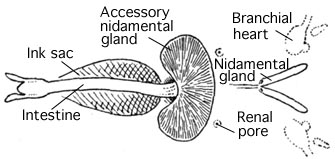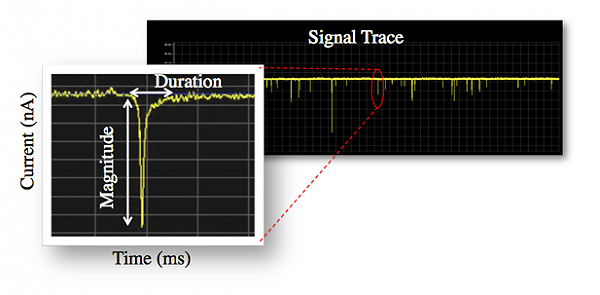|
Cephalopod Ink
Cephalopod ink is a dark-coloured or luminous ink released into water by most species of cephalopod, usually as an escape mechanism. All cephalopods, with the exception of the Nautilidae and the Cirrina (deep-sea octopuses), are able to release ink to confuse predators. The ink is released from the ink sacs (located between the gills) and is dispersed more widely when its release is accompanied by a jet of water from the siphon. Its dark color is caused by its main constituent, melanin. Each species of cephalopod produces slightly differently coloured inks; generally, octopuses produce black ink, squid ink is blue-black, and cuttlefish ink is a shade of brown. A number of other aquatic molluscs have similar responses to attack, including the gastropod clade known as sea hares. Types of ink shapes The shapes taken by ink releases are classified as six types: * pseudomorphs; * pseudomorph series; * ink ropes; * clouds/smokescreens; * diffuse puffs; * mantle fills. Ink ... [...More Info...] [...Related Items...] OR: [Wikipedia] [Google] [Baidu] |
Chtenopteryx Sicula2
''Chtenopteryx'' is a genus of small, muscular, midwater squid in the monotypic family Chtenopterygidae. Four species are presently recognized in the genus, but more are believed to exist. These squid occupy tropical to subtropical waters, probably at depths of between 500 and 1,000 m during the day and near-surface waters at night. The genus contains bioluminescent species. Species * '' Chtenopteryx canariensis'' Salcedo-Vargas & Guerrero-Kommritz, 2000 * '' Chtenopteryx chuni'' * Pfeffer Pfeffer is a German surname meaning "pepper" and may refer to: * Anna Pfeffer (born 1946), Hungarian Olympic medalist sprint canoer * Anshel Pfeffer, British journalist * Anton Pfeffer (born 1965), Austrian footballer * Big Jeff Pfeffer (1882� ..., 1912 * '' Chtenopteryx sepioloides'' Rancurel, 1970 * '' Chtenopteryx sicula'' (Vérany, 1851), comb-finned squid or toothed-fin squid The species listed above with an asterisk (*) is questionable and needs further study to determine if it ... [...More Info...] [...Related Items...] OR: [Wikipedia] [Google] [Baidu] |
Octopus Bocki
An octopus (plural, : octopuses or octopodes, Octopus#Etymology and pluralisation, see below for variants) is a soft-bodied, eight-cephalopod limb, limbed Mollusca, mollusc of the order (biology), order Octopoda (, ). The order consists of some 300 species and is grouped within the Class (biology), class Cephalopoda with squids, cuttlefish, and nautiloids. Like other cephalopods, an octopus is symmetry in biology, bilaterally symmetric with two eyes and a cephalopod beak, beaked mouth at the center point of the eight limbs. The soft body can radically alter its shape, enabling octopuses to squeeze through small gaps. They trail their eight appendages behind them as they swim. The Siphon (mollusc), siphon is used both for aquatic respiration, respiration and for aquatic locomotion#Jet propulsion, locomotion, by expelling a jet of water. Octopuses have a complex nervous system and excellent sight, and are among the most intelligent and behaviourally diverse of all invertebrate ... [...More Info...] [...Related Items...] OR: [Wikipedia] [Google] [Baidu] |
Tunable Resistive Pulse Sensing
Tunable Resistive Pulse Sensing (TRPS) is a single-particle technique used to measure the size, concentration and zeta potential of particles as they pass through a size-tunable nanopore. The technique adapts the principle of resistive pulse sensing, which monitors current flow through an aperture, combined with the use of tunable nanopore technology, allowing the passage of ionic current and particles to be regulated by adjusting the pore size. Technique Particles crossing a pore are detected one at a time as a transient change in the ionic current flow, which is denoted as a blockade event with its amplitude denoted as the blockade magnitude. As blockade magnitude is proportional to particle size, accurate particle sizing can be achieved after calibration with a known standard. Nanopore-based detection allows particle-by-particle assessment of complex mixtures. Optimization of pore size to particle size, by adjusting the stretch of the pore, can improve measurement accur ... [...More Info...] [...Related Items...] OR: [Wikipedia] [Google] [Baidu] |
Sepia Officinalis {{redirect category shell, {{R from other capitalisation{{R from move ...
#REDIRECT Common cuttlefish #REDIRECT Common cuttlefish #REDIRECT Common cuttlefish #REDIRECT Common cuttlefish {{redirect category shell, {{R from other capitalisation{{R from move ... {{redirect category shell, {{R from other capitalisation{{R from move ... {{redire ... [...More Info...] [...Related Items...] OR: [Wikipedia] [Google] [Baidu] |
Alarm Signal
In animal communication, an alarm signal is an antipredator adaptation in the form of signals emitted by social animals in response to danger. Many primates and birds have elaborate alarm calls for warning conspecifics of approaching predators. For example, the alarm call of the blackbird is a familiar sound in many gardens. Other animals, like fish and insects, may use non-auditory signals, such as chemical messages. Visual signs such as the white tail flashes of many deer have been suggested as alarm signals; they are less likely to be received by conspecifics, so have tended to be treated as a signal to the predator instead. Different calls may be used for predators on the ground or from the air. Often, the animals can tell which member of the group is making the call, so that they can disregard those of little reliability. Evidently, alarm signals promote survival by allowing the receivers of the alarm to escape from the source of peril; this can evolve by kin selection, ... [...More Info...] [...Related Items...] OR: [Wikipedia] [Google] [Baidu] |
Tyrosinase
Tyrosinase is an oxidase that is the rate-limiting enzyme for controlling the production of melanin. The enzyme is mainly involved in two distinct reactions of melanin synthesis otherwise known as the Raper Mason pathway. Firstly, the hydroxylation of a monophenol and secondly, the conversion of an o-diphenol to the corresponding o-quinone. o-Quinone undergoes several reactions to eventually form melanin. Tyrosinase is a copper-containing enzyme present in plant and animal tissues that catalyzes the production of melanin and other pigments from tyrosine by oxidation. It is found inside melanosomes which are synthesized in the skin melanocytes. In humans, the tyrosinase enzyme is encoded by the ''TYR'' gene. Catalyzed reaction Tyrosinase carries out the oxidation of phenols such as tyrosine and dopamine using dioxygen (O2). In the presence of catechol, benzoquinone is formed (see reaction below). Hydrogens removed from catechol combine with oxygen to form water. The ... [...More Info...] [...Related Items...] OR: [Wikipedia] [Google] [Baidu] |
Chemoreceptor
A chemoreceptor, also known as chemosensor, is a specialized sensory receptor which transduces a chemical substance (endogenous or induced) to generate a biological signal. This signal may be in the form of an action potential, if the chemoreceptor is a neuron, or in the form of a neurotransmitter that can activate a nerve fiber if the chemoreceptor is a specialized cell, such as taste receptors, or an internal peripheral chemoreceptor, such as the carotid bodies. In physiology, a chemoreceptor detects changes in the normal environment, such as an increase in blood levels of carbon dioxide (hypercapnia) or a decrease in blood levels of oxygen (hypoxia), and transmits that information to the central nervous system which engages body responses to restore homeostasis. In bacteria, chemoreceptors are essential in the mediation of chemotaxis. Cellular chemoreceptors In prokaryotes Bacteria utilize complex long helical proteins as chemoreceptors, permitting signals to travel lo ... [...More Info...] [...Related Items...] OR: [Wikipedia] [Google] [Baidu] |
Moray Eel
Moray eels, or Muraenidae (), are a family of eels whose members are found worldwide. There are approximately 200 species in 15 genera which are almost exclusively marine, but several species are regularly seen in brackish water, and a few are found in fresh water. The English name, from the early 17th century, derives from Portuguese , which itself derives from Latin , in turn from Greek , ; these are the Latin and Greek names of the Mediterranean moray. Anatomy The dorsal fin extends from just behind the head along the back and joins seamlessly with the caudal and anal fins. Most species lack pectoral and pelvic fins, adding to their serpentine appearance. Their eyes are rather small; morays rely mostly on their highly developed sense of smell, lying in wait to ambush prey. The body is generally patterned. In some species, the inside of the mouth is also patterned. Their jaws are wide, framing a protruding snout. Most possess large teeth used to tear flesh or grasp slipp ... [...More Info...] [...Related Items...] OR: [Wikipedia] [Google] [Baidu] |
Egg (biology)
An egg is an organic vessel grown by an animal to carry a possibly fertilized egg cell (a zygote) and to incubate from it an embryo within the egg until the embryo has become an animal fetus that can survive on its own, at which point the animal hatches. Most arthropods such as insects, vertebrates (excluding live-bearing mammals), and mollusks lay eggs, although some, such as scorpions, do not. Reptile eggs, bird eggs, and monotreme eggs are laid out of water and are surrounded by a protective shell, either flexible or inflexible. Eggs laid on land or in nests are usually kept within a warm and favorable temperature range while the embryo grows. When the embryo is adequately developed it hatches, i.e., breaks out of the egg's shell. Some embryos have a temporary egg tooth they use to crack, pip, or break the eggshell or covering. The largest recorded egg is from a whale shark and was in size. Whale shark eggs typically hatch within the mother. At and up to , ... [...More Info...] [...Related Items...] OR: [Wikipedia] [Google] [Baidu] |
Crab
Crabs are decapod crustaceans of the infraorder Brachyura, which typically have a very short projecting " tail" ( abdomen) ( el, βραχύς , translit=brachys = short, / = tail), usually hidden entirely under the thorax. They live in all the world's oceans, in freshwater, and on land, are generally covered with a thick exoskeleton, and have a single pair of pincers. They first appeared during the Jurassic Period. Description Crabs are generally covered with a thick exoskeleton, composed primarily of highly mineralized chitin, and armed with a pair of chelae (claws). Crabs vary in size from the pea crab, a few millimeters wide, to the Japanese spider crab, with a leg span up to . Several other groups of crustaceans with similar appearances – such as king crabs and porcelain crabs – are not true crabs, but have evolved features similar to true crabs through a process known as carcinisation. Environment Crabs are found in all of the world's oceans, as well as i ... [...More Info...] [...Related Items...] OR: [Wikipedia] [Google] [Baidu] |
Gastropoda
The gastropods (), commonly known as snails and slugs, belong to a large taxonomic class of invertebrates within the phylum Mollusca called Gastropoda (). This class comprises snails and slugs from saltwater, from freshwater, and from land. There are many thousands of species of sea snails and slugs, as well as freshwater snails, freshwater limpets, and land snails and slugs. The class Gastropoda contains a vast total of named species, second only to the insects in overall number. The fossil history of this class goes back to the Late Cambrian. , 721 families of gastropods are known, of which 245 are extinct and appear only in the fossil record, while 476 are currently extant with or without a fossil record. Gastropoda (previously known as univalves and sometimes spelled "Gasteropoda") are a major part of the phylum Mollusca, and are the most highly diversified class in the phylum, with 65,000 to 80,000 living snail and slug species. The anatomy, behavior, feeding, a ... [...More Info...] [...Related Items...] OR: [Wikipedia] [Google] [Baidu] |





.jpg)
